Detecting Water Loss Sink Points in Shallow Flooded Agricultural Environments Using a Visual Technique Based on Infrared Thermography: Laboratory Testing
Abstract
:1. Introduction
2. Materials and Methods
2.1. Laboratory Setup
2.2. Soil and Sink Characteristics
2.3. Video Recording System
2.3.1. Flooding of the Soil Surface
2.3.2. Tracer Application
2.4. Experimental Procedure
2.4.1. Flooding of the Soil Surface
2.4.2. Tracer Application
2.5. Image Processing
2.5.1. Flooding Process
2.5.2. Sink Detection Method
- Snapshots from the thermal videos were saved from time t0, when the tracer was applied to the flooded area, with a time lapse of ΔtTR.
- The FLIR DUO R infrared camera’s ability to record dual images enabled overlaying the thermal and real images on each other to obtain a clear vision of the flume and the thermal diffusion in the water layer over the soil surface.
- For each series of thermographs, a threshold temperature (τ) was established at 1 °C above the maximum temperature of the water observed in the flume before applying the tracer at time t0. This threshold temperature is used to separate the temperatures associated with the tracer plume from its surroundings. It helps identify pixels with temperature values exceeding the threshold temperature, effectively distinguishing them from the surrounding temperatures, which include pixels with temperature values below this threshold.The selection of an appropriate threshold temperature is crucial. A threshold equal to or lower than the water temperature within the flume where the sink is located would make it difficult to distinguish the thermal plume from its surroundings, as the entire image would appear uniformly colored. Conversely, setting the threshold too high (close to the maximum tracer temperature) would prevent observing the plume when it reaches the sink, as the temperature of its leading edge would have decreased below the tracer temperature by that point. In this study, a threshold of 1 °C above the maximum water temperature in the flume was sufficient to detect the movement of the thermal plume toward the sink.
- The thermal images were recorded at vertical and horizontal distorted angles. Therefore, to precisely determine the position of the leading edge of the tracer plume within the flume, these raw images were rectified and cropped to encompass the soil flume section. A computer-vision-based image rectification method known as Homography (matrix) was used to correct perspective distortion in the raw images, transforming non-parallel lines (due to the perspective) into a straightened version where lines are parallel [36,37]. This adjustment facilitates accurate distance measurements and ensures precise spatial analysis. The coordinates of the four corners of the soil flume were used in this approach for rectifying the raw images. This method transformed the distorted coordinates of the raw images into real metric coordinates using the dimensions of the flume as a reference.
- In each rectified image, the location of the tracer’s leading edge was determined starting from the image at time t1 (t0 + ΔtTR). The leading edge of the tracer’s plume was considered the furthest pixel in the X-axis direction (see Figure 3), with a temperature value above the threshold temperature. This process continued until the location of the leading edge was roughly the same (less than 0.1 m in both X-axis and Y-axis directions) in the last two images (e.g., from time t to t + ΔtTR), indicating that the tracer had reached the sink point. It was assumed that when the leading edge of the thermal tracer plume reached the sink point, the tracer started draining (seepage); therefore, the tracer’s leading-edge location remained approximately constant over time from that moment onward. Thus, this location was considered to be the location of the sink point in the flume.Each step was individually analyzed, and all procedures in each step were carried out using the MATLAB image processing toolbox and custom codes.
3. Results and Discussion
3.1. Flooding Phase
3.2. Sink Detection Phase
4. Conclusions
- The results highlight that tracer discharge can significantly influence the ability to detect the sink location, depending on the characteristics of the sink.
- The proposed sink detection technique successfully identified sink positions within the flooded area (laboratory flume), except in the case (scenario b) where the sink was filled with low-permeability soil and subjected to high tracer discharge.
- Sink characteristics, such as permeability, and the tracer discharge rate were crucial factors in successfully detecting the sink location.
Author Contributions
Funding
Institutional Review Board Statement
Data Availability Statement
Acknowledgments
Conflicts of Interest
References
- Food and Agriculture Organization of the United Nations (FAO). Water for Sustainable Food and Agriculture: A Report Produced for the G20 Presidency of Germany; FAO: Rome, Italy, 2017. [Google Scholar]
- Boyle, T.; Giurco, D.; Mukheibir, P.; Liu, A.; Moy, C.; White, S.; Stewart, R. Intelligent Metering for Urban Water: A Review. Water 2013, 5, 1052–1081. [Google Scholar] [CrossRef]
- Luciani, C.; Casellato, F.; Alvisi, S.; Franchini, M. Green smart technology for water (GST4Water): Water loss identification at user level by using smart metering systems. Water 2019, 11, 405. [Google Scholar] [CrossRef]
- Zaman, D.; Tiwari, M.K.; Gupta, A.K.; Sen, D. A review of leakage detection strategies for pressurised pipeline in steady-state. Eng. Fail. Anal. 2020, 109, 104264. [Google Scholar] [CrossRef]
- Aghda, S.F.; GanjaliPour, K.; Nabiollahi, K. Assessing the accuracy of TDR-based water leak detection system. Results Phys. 2018, 8, 939–948. [Google Scholar] [CrossRef]
- Xing, L.; Sela, L. Unsteady pressure patterns discovery from high-frequency sensing in water distribution systems. Water Res. 2019, 158, 291–300. [Google Scholar] [CrossRef] [PubMed]
- Zhou, X.; Tang, Z.; Xu, W.; Meng, F.; Chu, X.; Xin, K.; Fu, G. Deep learning identifies accurate burst locations in water distribution networks. Water Res. 2019, 166, 115058. [Google Scholar] [CrossRef]
- Hien, P.D.; Khoi, L.V. Application of Isotope Tracer Techniques for Assessing the Seepage of the Hydropower Dam at Tri An, South Vietnam. J. Radioanal. Nucl. Chem. 1996, 206, 295–303. [Google Scholar] [CrossRef]
- Lee, J.Y.; Kim, H.S.; Choi, Y.K.; Kim, J.W.; Cheon, J.Y.; Yi, M.J. Sequential Tracer Tests for Determining Water Seepage Paths in a Large Rockfill Dam, Nakdong River Basin, Korea. Eng. Geol. 2007, 89, 300–315. [Google Scholar] [CrossRef]
- Noraee-Nejad, S.; Sedghi-Asl, M.; Parvizi, M.; Shokrollahi, A. Salt Tracer Experiment through an Embankment Dam. Iranian J. Sci. Technol. Trans. Civil Eng. 2021, 45, 2787–2797. [Google Scholar] [CrossRef]
- Thu, H.; Van, S.; Trong, H.; Viet, H.; Huu, Q.; Thi, L. Determination of the Pore Water Velocity Using a Salt Tracer Combined with Self-Potential Measurements. J. Geosci. Environ. Prot. 2023, 11, 15–27. [Google Scholar] [CrossRef]
- Abrahams, A.D.; Parsons, A.J.; Luk, S.H. Field measurement of the velocity of overland flow using dye tracing. Earth Surf. Process. Landforms 1986, 11, 653–657. [Google Scholar] [CrossRef]
- Abrantes, J.R.; Moruzzi, R.B.; Silveira, A.; de Lima, J.L.M.P. Comparison of thermal, salt, and dye tracing to estimate shallow flow velocities: Novel triple-tracer approach. J. Hydrol. 2018, 557, 362–377. [Google Scholar] [CrossRef]
- de Lima, J.L.M.P.; Zehsaz, S.; de Lima, M.I.P.; Isidoro, J.M.; Jorge, R.G.; Martins, R.G. Using Quinine as a Fluorescent Tracer to Estimate Overland Flow Velocities on Bare Soil: Proof of Concept under Controlled Laboratory Conditions. Agronomy 2021, 11, 1444. [Google Scholar] [CrossRef]
- Zehsaz, S.; de Lima, J.L.M.P.; de Lima, M.I.P.; Isidoro, J.M.; Martins, R. Estimating Sheet Flow Velocities Using Quinine as a Fluorescent Tracer: Bare, Mulched, Vegetated and Paved Surfaces. Agronomy 2022, 12, 2687. [Google Scholar] [CrossRef]
- Zhang, G.H.; Luo, R.T.; Cao, Y.; Shen, R.C.; Zhang, X.C. Correction factor to dye-measured flow velocity under varying water and sediment discharges. J. Hydrol. 2010, 389, 205–213. [Google Scholar] [CrossRef]
- Kantoush, S.A.; Schleiss, A.J.; Sumi, T.; Murasaki, M. LSPIV implementation for environmental flow in various laboratory and field cases. J. Hydrol. Environ. Res. 2011, 5, 263–276. [Google Scholar] [CrossRef]
- Tauro, F.; Grimaldi, S.; Petroselli, A.; Porfiri, M. Fluorescent particle tracers for surface flow measurements: A proof of concept in a natural stream. Water Resour. Res. 2012, 48, W06528. [Google Scholar] [CrossRef]
- Tauro, F.; Piscopia, R.; Grimaldi, S. Streamflow observations from cameras: Large-scale particle image velocimetry or particle tracking velocimetry? Water Resour. Res. 2017, 53, 10374–10394. [Google Scholar] [CrossRef]
- Lei, T.; Chuo, R.; Zhao, J.; Shi, X.; Liu, L. An improved method for shallow water flow velocity measurement with practical electrolyte inputs. J. Hydrol. 2010, 390, 45–56. [Google Scholar] [CrossRef]
- Schuetz, T.; Weiler, M.; Lange, J.; Stoelzle, M. Two-dimensional assessment of solute transport in shallow waters with thermal imaging and heated water. Adv. Water Resour. 2012, 43, 67–75. [Google Scholar] [CrossRef]
- Zhou, J.; Liu, G.; Meng, Y.; Xia, C.; Chen, K.; Chen, Y. Using stable isotopes as tracer to investigate hydrological condition and estimate water residence time in a plain region. Chengdu, China. Sci. Rep. 2021, 11, 2812. [Google Scholar] [CrossRef]
- Abrantes, J.R.; de Lima, J.L.M.P.; Prats, S.A.; Keizer, J.J. Assessing soil water repellency spatial variability using a thermographic technique: An exploratory study using a small-scale laboratory soil flume. Geoderma 2017, 287, 98–104. [Google Scholar] [CrossRef]
- Danielescu, S.; MacQuarrie, K.T.; Faux, R.N. The integration of thermal infrared imaging, discharge measurements, and numerical simulation to quantify the relative contributions of freshwater inflows to small estuaries in Atlantic Canada. Hydrol. Process. 2009, 23, 2847–2859. [Google Scholar] [CrossRef]
- Mejías, M.; Ballesteros, B.J.; Antón-Pacheco, C.; Domínguez, J.A.; Garcia-Orellana, J.; Garcia-Solsona, E.; Masqué, P. Methodological study of submarine groundwater discharge from a karstic aquifer in the Western Mediterranean Sea. J. Hydrol. 2012, 464, 27–40. [Google Scholar] [CrossRef]
- Tonolla, D.; Acuna, V.; Uehlinger, U.; Frank, T.; Tockner, K. Thermal heterogeneity in river floodplains. Ecosystems 2010, 13, 727–740. [Google Scholar] [CrossRef]
- Bonar, S.A.; Petre, S.J. Ground-based thermal imaging of stream surface temperatures: Technique and evaluation. N. Am. J. Fish. Manag. 2015, 35, 1209–1218. [Google Scholar] [CrossRef]
- Pfister, L.; McDonnell, J.J.; Hissler, C.; Hoffmann, L. Ground-based thermal imagery as a simple, practical tool for mapping saturated area connectivity and dynamics. Hydrol. Process. 2010, 24, 3123–3132. [Google Scholar] [CrossRef]
- de Lima, J.L.M.P.; Abrantes, J.R. Using a thermal tracer to estimate overland and rill flow velocities. Earth Surf. Process. Landf. 2014, 30, 1293–1300. [Google Scholar] [CrossRef]
- de Lima, R.L.; Abrantes, J.R.; de Lima, J.L.M.P.; de Lima, M.I.P. Using thermal tracers to estimate flow velocities of shallow flows: Laboratory and field experiments. J. Hydrol. Hydromech. 2015, 63, 259. [Google Scholar] [CrossRef]
- Soliman, A.S.; Rahman, M.E.A.; Heck, R.J. Comparing time-resolved infrared thermography and X-ray computed tomography in distinguishing soil surface crusts. Geoderma 2010, 158, 101–109. [Google Scholar] [CrossRef]
- Shahraeeni, E.; Or, D. Thermo-evaporative fluxes from heterogeneous porous surfaces resolved by infrared thermography. Water Resour. Res. 2010, 46, W09511. [Google Scholar] [CrossRef]
- de Lima, J.L.M.P.; Abrantes, J.R.; Silva, V.P.; Montenegro, A.A. Prediction of skin surface soil permeability by infrared thermography: A soil flume experiment. Quant. Infrared Thermogr. J. 2014, 11, 161–169. [Google Scholar] [CrossRef]
- de Lima, J.L.M.P.; Abrantes, J.R.; Silva, V.P.; de Lima, M.I.P.; Montenegro, A.A. Mapping soil surface macropores using infrared thermography: An exploratory laboratory study. Sci. World J. 2014, 2014, 8845460. [Google Scholar] [CrossRef] [PubMed]
- Águas de Coimbra. Quality Control of Water Intended for Human Consumption—Municipality of Coimbra—Boavista Supply Area—1st Semester 2020; Technical Report; Águas de Coimbra: Coimbra, Portugal, 2020. (In Portuguese) [Google Scholar]
- Hartley, R.; Zisserman, A. Multiple View Geometry in Computer Vision, 2nd ed.; Cambridge University Press: Cambridge, UK, 2004. [Google Scholar]
- Szeliski, R. Computer Vision: Algorithms and Applications; Springer Nature: Berlin/Heidelberg, Germany, 2022. [Google Scholar]
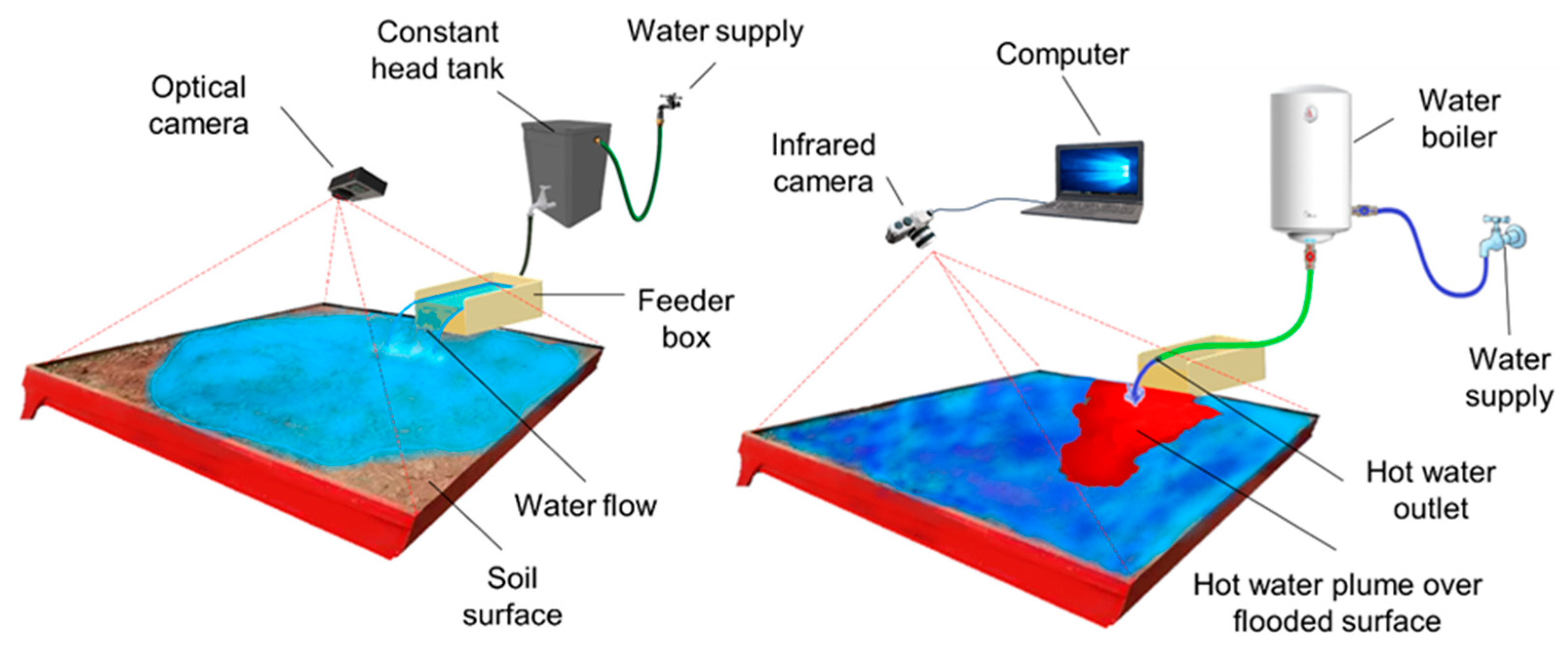
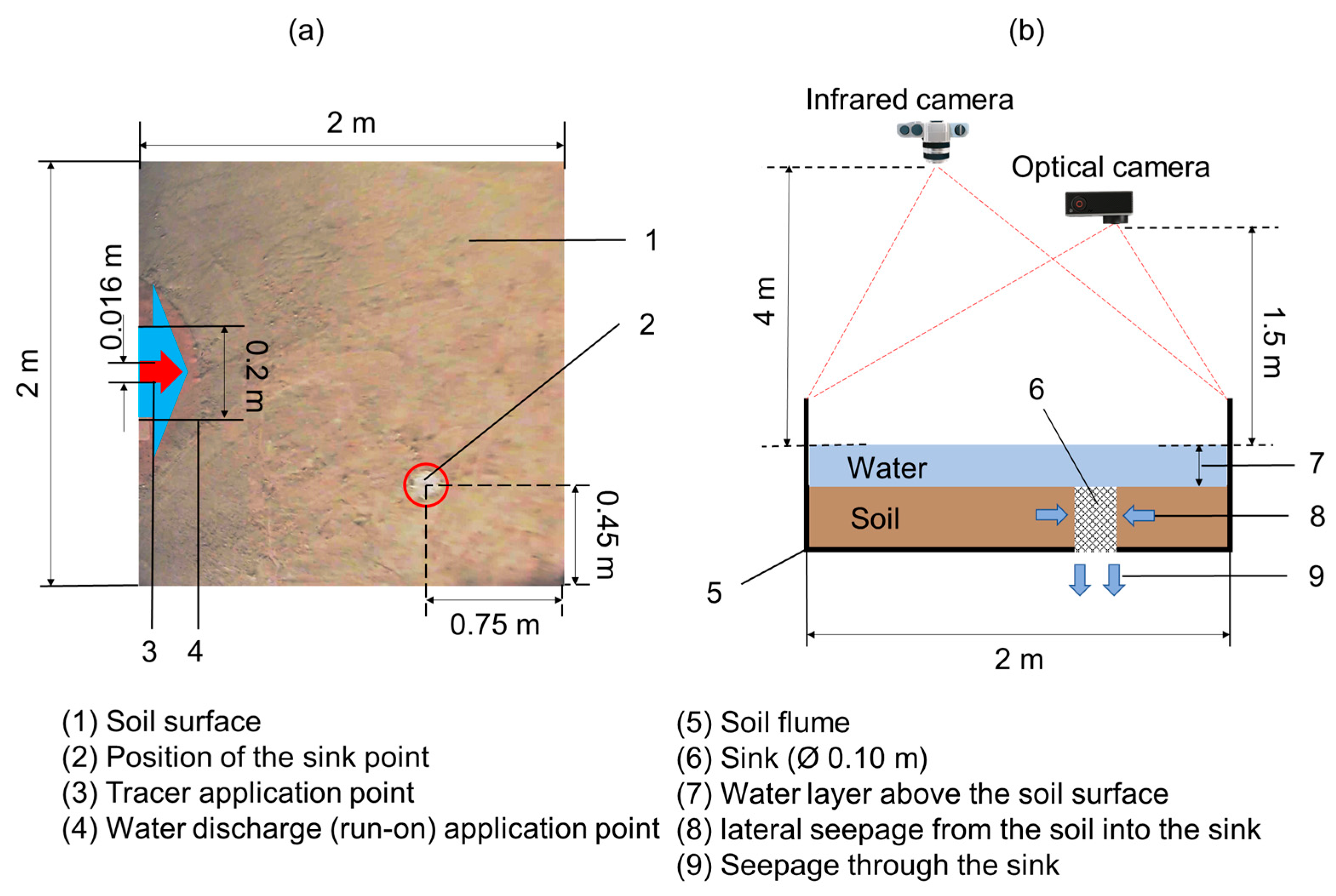
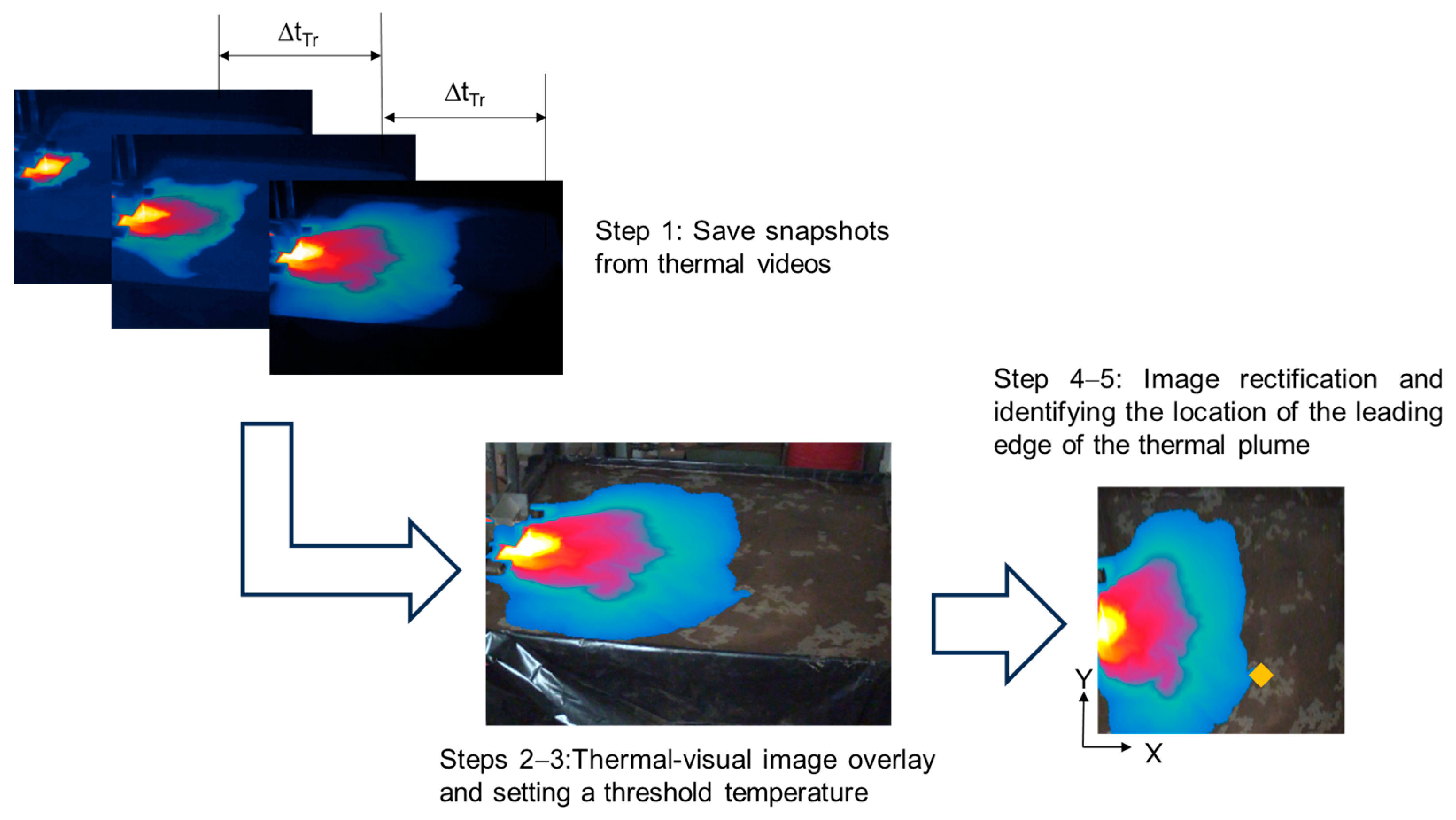


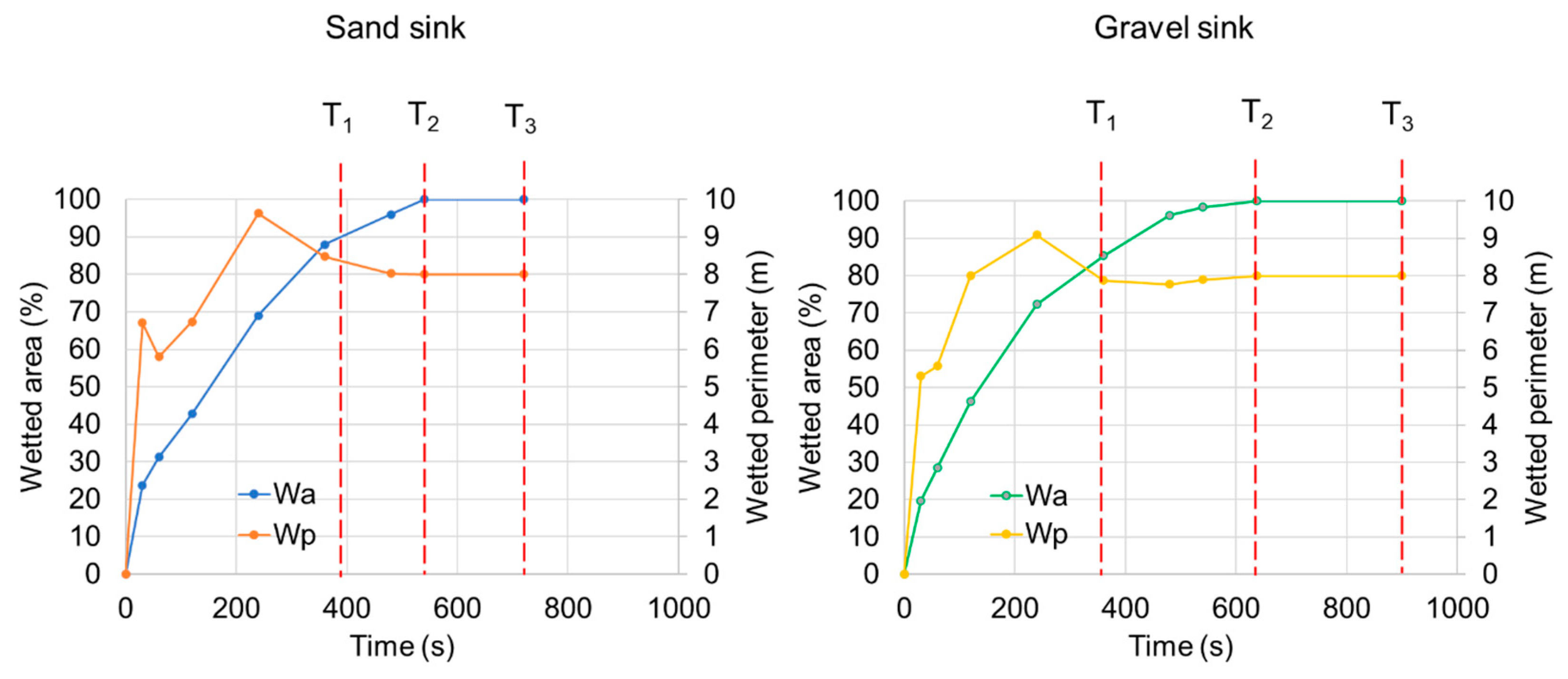


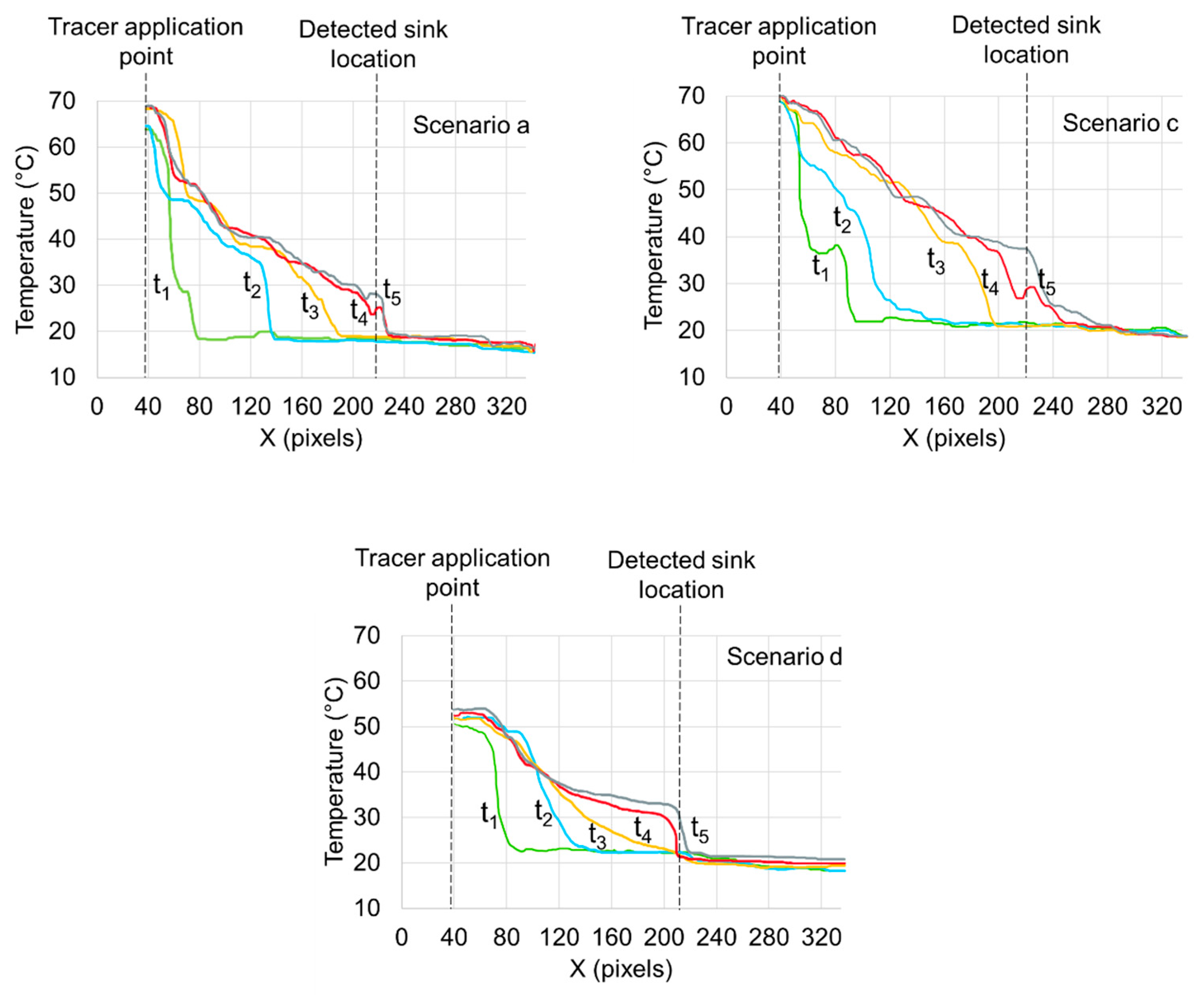
| Scenario | Sink Material | Permeability | Saturated Hydraulic Conductivity (mm/s) | Tracer Discharge (L/s) |
|---|---|---|---|---|
| a | Sand | Low | 0.24 | 0.025 |
| b | Sand | Low | 0.24 | 0.035 |
| c | Gravel | High | 2.02 | 0.025 |
| d | Gravel | High | 2.02 | 0.035 |
Disclaimer/Publisher’s Note: The statements, opinions and data contained in all publications are solely those of the individual author(s) and contributor(s) and not of MDPI and/or the editor(s). MDPI and/or the editor(s) disclaim responsibility for any injury to people or property resulting from any ideas, methods, instructions or products referred to in the content. |
© 2024 by the authors. Licensee MDPI, Basel, Switzerland. This article is an open access article distributed under the terms and conditions of the Creative Commons Attribution (CC BY) license (https://creativecommons.org/licenses/by/4.0/).
Share and Cite
Zehsaz, S.; de Lima, J.L.M.P.; de Lima, M.I.P. Detecting Water Loss Sink Points in Shallow Flooded Agricultural Environments Using a Visual Technique Based on Infrared Thermography: Laboratory Testing. Agriculture 2024, 14, 1366. https://doi.org/10.3390/agriculture14081366
Zehsaz S, de Lima JLMP, de Lima MIP. Detecting Water Loss Sink Points in Shallow Flooded Agricultural Environments Using a Visual Technique Based on Infrared Thermography: Laboratory Testing. Agriculture. 2024; 14(8):1366. https://doi.org/10.3390/agriculture14081366
Chicago/Turabian StyleZehsaz, Soheil, João L. M. P. de Lima, and M. Isabel P. de Lima. 2024. "Detecting Water Loss Sink Points in Shallow Flooded Agricultural Environments Using a Visual Technique Based on Infrared Thermography: Laboratory Testing" Agriculture 14, no. 8: 1366. https://doi.org/10.3390/agriculture14081366
APA StyleZehsaz, S., de Lima, J. L. M. P., & de Lima, M. I. P. (2024). Detecting Water Loss Sink Points in Shallow Flooded Agricultural Environments Using a Visual Technique Based on Infrared Thermography: Laboratory Testing. Agriculture, 14(8), 1366. https://doi.org/10.3390/agriculture14081366







